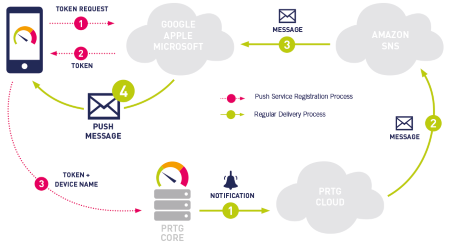This article applies as of PRTG 22
The PRTG Cloud and push notifications
As of PRTG 15.4.20, you can use the notification type Push Notifications for your network monitoring together with the PRTG apps PRTG for Android (as of PRTG 14.3.2) and PRTG for iOS (as of PRTG 14.3.6). The article How can I use push notifications with PRTG? explains how to set up and work with push notifications.
Of course, the underlying approach of sending push notifications from your PRTG core server to your smartphone is a bit more complex. There are several components which have to interact to process push messages and send them to the correct target device.
The following graphic illustrates the push notification process, the involved components, and how the components interact until you receive the push notification on your mobile device:

Click here to enlarge.
You can see two processes in the graphic:
- The push service registration process to register your mobile device for push notifications.
- The regular delivery process that describes the steps to send a notification as a push message to your target device through the PRTG Cloud.
Note: The PRTG core server must have access to the internet to reach the PRTG Cloud under https://api.prtgcloud.com:443. If you use Cloud HTTP v2 and Cloud Ping v2 sensors, this also applies to the probe systems with these sensors.
Note: PRTG versions previous to PRTG 15.4.20 do not support cloud features anymore because we changed the cloud infrastructure with this version. If you run a previous version of PRTG, update your PRTG core server to use push notifications and other PRTG Cloud services.
Push service registration process
There are three steps necessary for PRTG to register your device for push messages:
- When you activate push messages in your PRTG app as described in section First Time Setup in How can I use push notifications with PRTG?, the app requests a token from the cloud of your mobile device's platform (Google or Apple) to register with this cloud. This token is a unique identifier for your mobile device so that the respective cloud service can send the push message to the correct device. The used messaging clouds are:
- The messaging clouds of Google or Apple assign the token to your mobile device to uniquely identify it later.
- The PRTG app sends this unique token to your PRTG core server. This creates a new entry in your PRTG web interface in the Notification Contacts of the user account that you connected to. Your mobile device will appear with its name and the token in the contacts list.

Click here to enlarge.
- If you register a mobile device for the first time and the registration process has been successfully completed, you will receive a confirming push message.
This process is repeated for each user account that uses push notifications. Because the tokens that the PRTG apps get from their respective cloud services platform expire from time to time, this process is regularly repeated to replace the old tokens with new ones. It is therefore not possible to add the tokens by hand. The PRTG apps need to be able to connect to the PRTG core server for push notifications to be reliable.
Regular delivery process of push messages
Once you have registered your mobile device for push messages, you can create push notifications and set up corresponding notification triggers in PRTG. Triggered push notifications will immediately appear in the notification area of your mobile device.
For this, the notification has to go through several steps:
- When a push notification is triggered by a sensor in PRTG, the PRTG core server sends the notification with the specified information (“Message” in the push notification settings) about this incident to the PRTG Cloud.
- The PRTG Cloud checks the license key of your PRTG core server and processes the notification accordingly. For example, it applies the flood protection mechanism to ensure that your mobile device will not be flooded with too many messages. The PRTG Cloud converts the notification into a push message with all necessary information, including the token to identify the correct target device, and sends the message to Amazon SNS (Simple Notification Service).
- Like the PRTG Cloud, Amazon SNS checks several properties of the message, queues it if necessary so that it will not get lost, and automatically converts it into the correct format for the vendor-specific messaging cloud. Amazon SNS ensures that the push message is always passed along in the correct format, provides high availability, and delivers messages very fast.
- The respective messaging cloud uses the unique token of the push message to identify the destination and pushes it to your Android or iOS device where it immediately appears in the notification area.
Although the regular delivery process for push messages involves several steps and components, a push notification will usually appear on your mobile device within moments after being triggered in PRTG.
However, because unexpected things can always happen in the IT (server outages, network outages that disrupt connections between the involved components, or failures on your mobile device), we strongly recommend that you always create at least two notifications with different delivery methods for your critical systems.
For more information, also see the article Is there an FAQ for push notifications?
More


Add comment